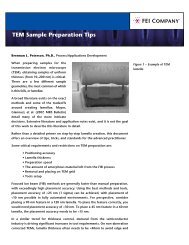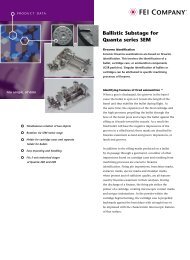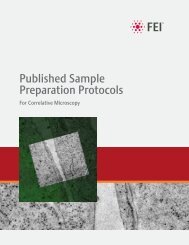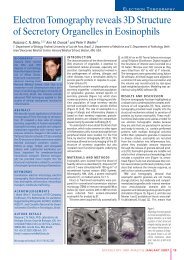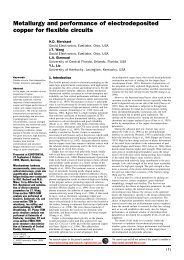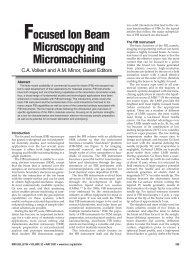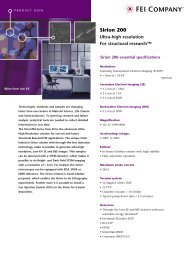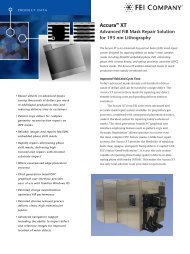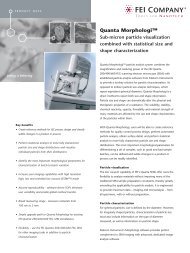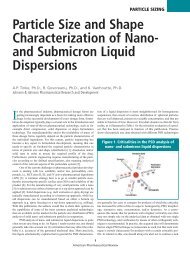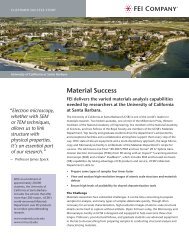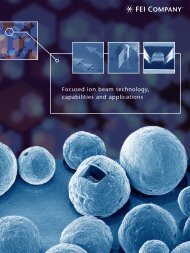Wet STEM: A newdevelopment in environmental SEM for imaging ...
Wet STEM: A newdevelopment in environmental SEM for imaging ...
Wet STEM: A newdevelopment in environmental SEM for imaging ...
You also want an ePaper? Increase the reach of your titles
YUMPU automatically turns print PDFs into web optimized ePapers that Google loves.
294<br />
Fig. 3. Colloidal solution of gold nano-particles imaged at<br />
30 kV <strong>in</strong> wet mode with the annular dark-field <strong>STEM</strong> detector.<br />
Average particles size: 20 nm. Scale bar length: 200 nm.<br />
excellent result partly thanks to the field emission<br />
source.<br />
Particles with similar sizes but with a less<br />
favourable atomic number difference with water<br />
have then been chosen to evaluate wet <strong>STEM</strong><br />
per<strong>for</strong>mances. A colloidal suspension of silica<br />
particles, supplied by Buehler under the commercial<br />
name Mastermet s 2, has been observed.<br />
Referr<strong>in</strong>g to the commercial catalogue, monodisperse<br />
particles with a size around 20 nm were<br />
expected. Fig. 4 shows two images at different<br />
magnifications, *15,000 and *120,000, respectively.<br />
On the first image, the large several mmwide<br />
circle is a hole <strong>in</strong> the carbon layer of the TEM<br />
grid. <strong>Wet</strong> <strong>STEM</strong> images showa wide dispersion <strong>in</strong><br />
particle sizes, rang<strong>in</strong>g from 20 to 100 nm. Above<br />
the carbon grid hole, a water meniscus has been<br />
<strong>for</strong>med, so that biggest particles have been rejected<br />
on edges, where the water layer is thicker. On<br />
every po<strong>in</strong>t of the hole area, as the water layer is<br />
just slightly thicker than the particles and the Z<br />
number of particles is greater than that of water,<br />
one can observe a classical dark field contrast, i.e.<br />
larger particles appear brighter.<br />
From these examples, one can see that metallic<br />
and <strong>in</strong>organic nano-objects <strong>in</strong> water observed <strong>in</strong><br />
wet <strong>STEM</strong> exhibit <strong>in</strong>terest<strong>in</strong>g resolution and<br />
contrast. The follow<strong>in</strong>g example concerns organic<br />
nano-objects: multi-walls carbon nanotubes, dispersed<br />
<strong>in</strong> water [7]. <strong>Wet</strong> <strong>STEM</strong> image on Fig. 5 is<br />
ARTICLE IN PRESS<br />
A. Bogner et al. / Ultramicroscopy 104 (2005) 290–301<br />
Fig. 4. Colloidal solution of silica particles (polish<strong>in</strong>g product<br />
Mastermet 2 supplied by Buehler) imaged at 30 kV <strong>in</strong> wet mode<br />
<strong>in</strong> annular dark-field conditions. Particles size ranges from 20 to<br />
100 nm.<br />
Fig. 5. Carbon nanotubes <strong>in</strong> water imaged at 30 kV <strong>in</strong> wet<br />
mode <strong>in</strong> annular dark-field conditions.



